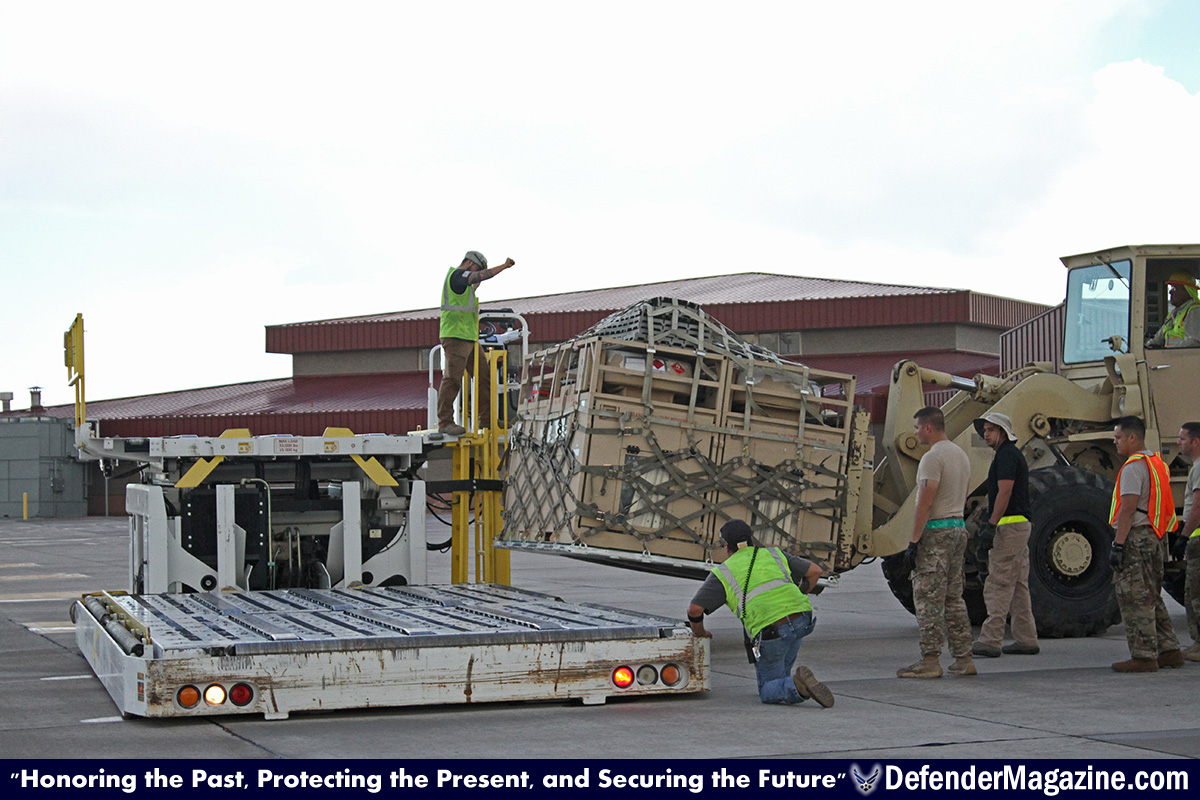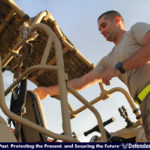
07/31/2017 – FORT BLISS, Texas – LOGDET. It’s a win-win-win that ultimately means the Air Force has a better chance of accomplishing its many missions with less loss of life and resources.
The recently established Air Force security forces logistics detail, or LOGDET, equipment centralization center means valuable, serviceable and, oftentimes, state-of-the-art equipment can be delivered into the hands of Air Force Defenders who need it; in less than 96 hours in some cases.
Located at the Air Force Security Forces Center’s Desert Defender Ground Combat Readiness Training Center at Fort Bliss, Texas, LOGDET is expected to be designated at full operational capability in October.
Before LOGDET, security forces equipment was scattered at installations across the service with each unit having the responsibility of inventorying and shipping it to a middle location for consolidation before it was sent downrange to those who needed it.
“(Now) everything comes from Fort Bliss. There’s no having to shotgun from three or four different bases. It all just loads here and comes together as a whole,” said Master Sgt. Brent Helman, LOGDET superintendent.
Not only does the LOGDET program save valuable time, it also ensures the right equipment – in serviceable condition – gets to Defenders at forward locations.
“(At the beginning of the program) teams went out and consolidated equipment and began the process to bring it here to Fort Bliss,” Helman said. “During that consolidation, it was discovered that a lot of equipment was antiquated or just not in use anymore so we started a joint modernization effort along with the consolidation.”
In addition to saving unit commanders more than 1,300 man hours a month that would have been spent on inventory and equipment posturing, as well as equipment costs, “we’re modernizing equipment to meet the 21st century adversaries that we face,” he said.
The LOGDET currently has roughly $250 million in assets but that includes old and antiquated equipment destined for the Defense Reutilization and Marketing Office or destruction.
Partnering with its parent organization, the Air Force Security Forces Center, Helman said they’ve submitted a proposal for approximately $240 million to modernize equipment and continue consolidation across the enterprise.
Realizing the importance of standing up a responsive, agile organization, Helman said the team reached out to different functional communities – such as supply and aerial port operations – to learn from their successes and failures.
“Supply chain management was a huge learning curve for us as security forces,” the superintendent said. “We’re lucky enough here at Desert Defender to have two (supply AFSCs) assigned.”
Staff Sgt. Aaron Hale is one of LOGDET’s supply specialists and understands what the centralized system means to security forces members.
“(With LOGDET) they know where they’re getting their assets from. They know we are reliable and the assets they are getting will work,” Hale said.
With LOGDET, it’s now very easy to inventory, keep accountability and purge and replace equipment that’s no longer relevant, the supply specialist said. And, ultimately, quickly get the right equipment in the hands of Defenders who need it.
“If these assets don’t get to where they need to be, it could potentially put lives in jeopardy,” Hale said.
With no aerial port specialists assigned to LOGDET, Helman recently set up training and demonstrations on aerial port operations by seasoned senior NCOs in that career field. The curriculum included joint inspections, cargo preparation and needed documentation.
“With this training, we can seamlessly flow from preparation here in the yard through the process, right on a military or civilian aircraft to go downrange,” he said.
At LOGDET, Helman and his team doesn’t deal with uniforms and personal equipment, but rather capability sets for defense forces commanders.
“If you need a weapon, like an M-4 or an M-9, we’re not who you call,” he said. “If you need heavy weapons, entry control point equipment, MRZRs (off-road utility vehicles), tactical automated security systems … that’s what we do. We help you robust the base as far as infrastructure and defense support equipment to help secure a flight line or an airbase.”
Helman gives the example of a new, bare-base location.
“That’s definitely where our meat and potatoes are,” he said. “You’re standing up a new base – it’s just a patch of dirt with a flight line – and you have nothing.”
Additionally, Helman said LOGDET can provide great assistance when a significant security capability is deficient in an overseas theater of operations.
“We can spring into action and get them what they need,” he said.
“My previous deployments, and I’ve got a couple of deployments under my belt, there were many times that we may not have had the right equipment or had old equipment or equipment that had malfunctioned or broken,” said Staff Sgt. Dale Wilson, LOGDET tactical automated security systems specialist.
Without LOGDET, the mission would get done, Wilson said, “Because that’s what we do in the military,” but it would be much more difficult.
“LOGDET brings to the security forces field a force multiplier … it brings equipment, it brings speed, it brings things to the fight that most people won’t ever see except those Defenders that need it,” the NCO said.
“The equipment that we bring to the fight is the right equipment at the right time and it’s the most capable, up-to-date equipment possible. That’s what our Defenders need downrange,” Wilson added.
Although LOGDET is expected to officially be designated FOC Oct. 1, Helman said he sees it as just a formal declaration.
“We have proven time and time again over the year that the process and support we can provide is FOC,” he said. “We’ve been supporting several different combatant commands and major commands … the formal declaration on a piece of paper just announces it to the rest of the security forces enterprise.”
Story by Deborah Aragon
Air Force Installation and Mission Support Center
Logistics Detail Airmen with Air Force Security Forces Center’s Desert Defender Ground Combat Readiness Training Center and Biggs Army Air Field aerial port work together to preposition equipment at Fort Bliss, Texas, July 25, 2017. The Airmen are shipping the gear to Defenders downrange. (U.S. Air Force photo by Debbie Aragon)
Desmond Jones, left, and David Rodriguez, Logistics Detail, Desert Defender Ground Combat Readiness Training Center, Air Force Security Forces Center, inventory obsolete generators before turn-in at Fort Bliss, Texas, July 25, 2017. In addition to centralizing all security forces capabilities sets, LOGDET is also modernizing equipment to make sure inventory “meets the 21st century adversaries” Defenders face downrange. (U.S. Air Force photo by Debbie Aragon)
Staff Sgt. Dale Wilson, a Logistics Detail Airman with the Air Force Security Forces Center’s Desert Defender Ground Combat Readiness Training Center, unpacks, inspects and verifies equipment before it’s stored at Fort Bliss, Texas, July 25, 2017. LOGDET, the new centralized security forces equipment center, means the right capability sets can quickly get in to the hands of Defenders who need them. (U.S. Air Force photo by Debbie Aragon)
Staff Sgt. Dale Wilson and David Rodriguez, Logistics Detail Airmen with the Air Force Security Forces Center’s Desert Defender Ground Combat Readiness Training Center, walk through one of several warehouses that store unique security forces capabilities sets at Fort Bliss, Texas, July 25, 2017. The sets, to include things like entry control point equipment, heavy weapons and tactical automated security systems, are ready for rapid deployment to Defenders who need it downrange. (U.S. Air Force photo by Debbie Aragon)
Master Sgt. William Linford, air terminal manager at Joint Base Langley-Eustis, Virginia, conducts a class on pallet buildup for Logistics Detail team members with the Air Force Security Forces Center’s Desert Defender Ground Combat Readiness Training Center at Fort Bliss, Texas, July 25, 2017. The training helps make sure pallets built by LOGDET members are ready to go when they arrive at cargo staging areas so there are minimal delays in needed equipment reaching Defenders downrange. (U.S. Air Force photo by Debbie Aragon)
Senior Airman Brian Jackson, a logistics detail team member with the Air Force Security Forces Center’s Desert Defender Ground Combat Readiness Training Center checks to make sure an MRZR off-road utility vehicle is ready for shipment to Defender’s downrange at Fort Bliss, Texas, July 25, 2017. Jackson, a communications specialist, is one of several specialties that make up the new LOGDET. (U.S. Air Force photo by Debbie Aragon)
Logistics Detail Airmen with the Air Force Security Forces Center’s Desert Defender Ground Combat Readiness Training Center and Biggs Army Air Field aerial port personnel work together to prepare and load load MRZR off-road utility vehicles to send to Defenders downrange at Fort Bliss, Texas, July 25, 2017. (U.S. Air Force photo by Debbie Aragon)
Logistics Detail Airmen with the Air Force Security Forces Center’s Desert Defender Ground Combat Readiness Training Center and Biggs Army Air Field aerial port personnel work together to prepare and load equipment to send to Defenders downrange at Fort Bliss, Texas, July 25, 2017. (U.S. Air Force photo by Debbie Aragon)
Logistics Detail Airmen with the Air Force Security Forces Center’s Desert Defender Ground Combat Readiness Training Center and Biggs Army Air Field aerial port personnel work together to prepare and load equipment to send to Defenders downrange at Fort Bliss, Texas, July 25, 2017. (U.S. Air Force photo by Debbie Aragon)
Logistics Detail Airmen with the Air Force Security Forces Center’s Desert Defender Ground Combat Readiness Training Center and Biggs Army Air Field aerial port personnel work together to prepare and load equipment to send to Defenders downrange at Fort Bliss, Texas, July 25, 2017. (U.S. Air Force photo by Debbie Aragon)
Logistics Detail Airmen with the Air Force Security Forces Center’s Desert Defender Ground Combat Readiness Training Center and Biggs Army Air Field aerial port personnel work together to prepare and load equipment to send to Defenders downrange at Fort Bliss, Texas, July 25, 2017. (U.S. Air Force photo by Debbie Aragon)
Logistics Detail Airmen with the Air Force Security Forces Center’s Desert Defender Ground Combat Readiness Training Center and Biggs Army Air Field aerial port personnel work together to prepare and load equipment to send to Defenders downrange at Fort Bliss, Texas, July 25, 2017. (U.S. Air Force photo by Debbie Aragon)
Members of the Air Force Security Forces Center Desert Defender Ground Combat Readiness Training Center’s Logistics Detail pause for a photo recently after completing a late-night mission to load equipment for Defenders downrange. Although not yet certified at full operational capability, the new unit has already supported various requests from combatant and major commands. (U.S. Air Force photo/Debbie Aragon)












